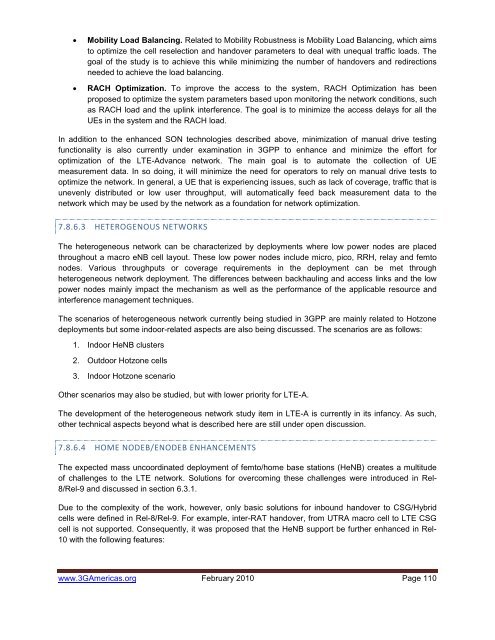UMTS: Alive and Well - 4G Americas
UMTS: Alive and Well - 4G Americas
UMTS: Alive and Well - 4G Americas
Create successful ePaper yourself
Turn your PDF publications into a flip-book with our unique Google optimized e-Paper software.
• Mobility Load Balancing. Related to Mobility Robustness is Mobility Load Balancing, which aimsto optimize the cell reselection <strong>and</strong> h<strong>and</strong>over parameters to deal with unequal traffic loads. Thegoal of the study is to achieve this while minimizing the number of h<strong>and</strong>overs <strong>and</strong> redirectionsneeded to achieve the load balancing.• RACH Optimization. To improve the access to the system, RACH Optimization has beenproposed to optimize the system parameters based upon monitoring the network conditions, suchas RACH load <strong>and</strong> the uplink interference. The goal is to minimize the access delays for all theUEs in the system <strong>and</strong> the RACH load.In addition to the enhanced SON technologies described above, minimization of manual drive testingfunctionality is also currently under examination in 3GPP to enhance <strong>and</strong> minimize the effort foroptimization of the LTE-Advance network. The main goal is to automate the collection of UEmeasurement data. In so doing, it will minimize the need for operators to rely on manual drive tests tooptimize the network. In general, a UE that is experiencing issues, such as lack of coverage, traffic that isunevenly distributed or low user throughput, will automatically feed back measurement data to thenetwork which may be used by the network as a foundation for network optimization.7.8.6.3 HETEROGENOUS NETWORKSThe heterogeneous network can be characterized by deployments where low power nodes are placedthroughout a macro eNB cell layout. These low power nodes include micro, pico, RRH, relay <strong>and</strong> femtonodes. Various throughputs or coverage requirements in the deployment can be met throughheterogeneous network deployment. The differences between backhauling <strong>and</strong> access links <strong>and</strong> the lowpower nodes mainly impact the mechanism as well as the performance of the applicable resource <strong>and</strong>interference management techniques.The scenarios of heterogeneous network currently being studied in 3GPP are mainly related to Hotzonedeployments but some indoor-related aspects are also being discussed. The scenarios are as follows:1. Indoor HeNB clusters2. Outdoor Hotzone cells3. Indoor Hotzone scenarioOther scenarios may also be studied, but with lower priority for LTE-A.The development of the heterogeneous network study item in LTE-A is currently in its infancy. As such,other technical aspects beyond what is described here are still under open discussion.7.8.6.4 HOME NODEB/ENODEB ENHANCEMENTSThe expected mass uncoordinated deployment of femto/home base stations (HeNB) creates a multitudeof challenges to the LTE network. Solutions for overcoming these challenges were introduced in Rel-8/Rel-9 <strong>and</strong> discussed in section 6.3.1.Due to the complexity of the work, however, only basic solutions for inbound h<strong>and</strong>over to CSG/Hybridcells were defined in Rel-8/Rel-9. For example, inter-RAT h<strong>and</strong>over, from UTRA macro cell to LTE CSGcell is not supported. Consequently, it was proposed that the HeNB support be further enhanced in Rel-10 with the following features:www.3G<strong>Americas</strong>.org February 2010 Page 110
















